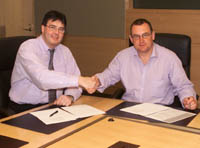REDMOND, Wash., Feb. 4, 2002 — When it comes to education, many nations might do well to take a leaf from New Zealand’s lesson book. In 2000, 15-year-olds from 32 of the world’s most developed nations were tested as part of the Program for International Student Assessment, which measured how well the students could apply knowledge in three subjects. U.S. students had average results — 14th in literacy and 18th in math. In contrast, New Zealand students placed third in both subjects — behind Canada and Finland in literacy and behind Japan and Korea in math.

Mark East, Microsoft Worldwide Manager, Education Solutions Group (left), and Trevor Mallard, New Zealand Minister of Education, sign an agreement that will provide all of New Zealand’s government-funded schools with the latest Microsoft software. Click for high-resolution image
New Zealand also developed the Reading Recovery program, which helps low-achieving 6-year-olds learn to read. With such an impressive r
é
sum
é
in education, it should come as no surprise that the country has taken the significant step of equipping its students and classrooms with the latest technology. Today, Trevor Mallard, New Zealand Minister of Education, and Mark East, worldwide general manager of Microsoft’s Education Solutions Group, signed an agreement that will provide all of New Zealand’s government-funded schools — approximately 70,000 PCs overall — with the latest Microsoft software.
“We are proud of the progress New Zealand schools have made in using information and communication technology to deliver a high standard of education,” Mallard says. “The agreement with Microsoft is another positive step forward.”
East says it was a privilege to work with the New Zealand government on the agreement, which demonstrates both parties’ commitment to educating future leaders.
“As the new economy develops, it is important that governments and organizations such as Microsoft work together to provide schools with the necessary modern learning infrastructures,” East says. “This agreement integrates technology into classroom instruction and school administration, and helps to provide students, educators, administrators and parents with any-time, any-place access to learning.”
Over the next two years, New Zealand schools will receive Microsoft software valued at NZ$10 million (US$4.2 million), including: Microsoft Office XP Professional and Office:Mac 2001; Microsoft Works; Microsoft Windows operating system upgrades to Windows XP; Microsoft FrontPage; Microsoft BackOffice client access licenses; Microsoft Encarta Reference Suite; and Microsoft Visual Studio Professional.
Jane Edgar, a teacher and Information and Communication Technologies (ICT) director at a primary school in Auckland, says that not having to worry about budget and the legality of the software she uses will be a significant advantage. “We can adjust our priorities so that instead of worrying about how we’re going to get the software and how we’re going to license it, we’re now thinking about how we’re going to use it,” she says. “It’s something we’ve wanted for a long time, but never thought we’d get. You’re chewing on a dry cracker and then someone comes along and says, ‘Here’s a box of assorted chocolate biscuits that you can have any time you want.'”
In the New Zealand education system, schools are ranked by what are called “deciles.” A decile 10 school receives no additional government funding, whereas a decile 1 school receives significant assistance. Resources are distributed at the discretion of individual schools, which means that IT funding was dependent upon how important those in charge viewed it to be. Additionally, funds used toward one area obviously meant that those same funds could not be used in another. Edgar says that she had to “beg, borrow and steal” from other areas of the budget to meet her IT needs, and relied upon donations and fundraising to supply the rest.
Peter Bloch, a teacher and systems administrator at Tokora High School in the Central North Island of New Zealand, agrees. “Microsoft and the government have provided the bread and butter, and now we can think about what other toppings we want,” he says. “It frees up resources for us to spend the money on other software we would like, such as Exchange Server.”
Bloch says that technology is a springboard to a higher level of thinking. “Technology exposes our kids to a wide range of experiences that simply wouldn’t be available in a small town of 15,000 in the middle of New Zealand,” he says. “Now we’ve got kids who know what’s going on around the world.”
One of the most important resources schools will now be able to provide is professional development for their teachers, Edgar adds.
“Many times, schools will say they cannot transform their classrooms and provide training for teachers because they don’t have the money,” says Cheryl Williams, president of the International Society for Technology in Education. “When the government steps up and spends this kind of money, it sends a message; it provides leadership that local schools need. It’s a wonderful opportunity for the children and the educators in New Zealand to make a jumpstart forward.”
Independent schools can also purchase licenses at the same price as the Ministry of Education, thereby ensuring that all schools in New Zealand will be able to benefit.
“There’s a real drive to use computers to learn with and from, there’s a big push for information literacy throughout the world, and New Zealand is small enough to really achieve it,” Edgar says. New Zealand is home to approximately 3.6 million people.
The agreement, signed today in Redmond, Wash., offers the Ministry of Education significant cost savings on Microsoft’s standard licensing programs. The agreement also provides schools with a centralized procurement process, making it easier for schools to obtain and manage their software. The core component of the software package is also available to all primary and secondary teachers and other staff on their home computers.
“By giving our children the latest and best, we’re telling them it’s worth having,” Edgar says. “And they’re worth giving it to.”




